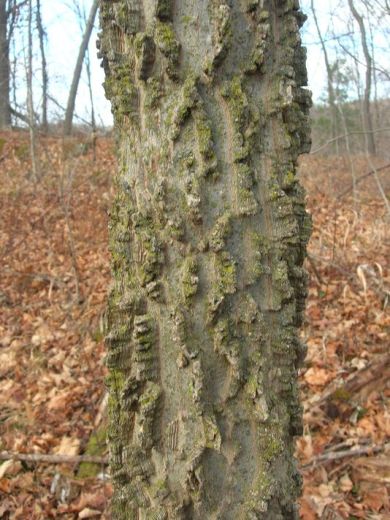
Cork Elm is only known from five locations in the Champlain Valley, Vermont. It was added to the Vermont Endangered and Threatened Species List in 2011. / © Bob Popp
When searching for rare or endangered plants, glancing down at your feet is the most effective approach despite resulting in occasional collisions with trees and inanimate objects.
In Vermont we’re fortunate that critical habitat for rare species still exists. In fact, just recently, two of Vermont’s most endangered plants were rediscovered. An extensive colony of the state threatened Flowering Dogwood (Cornus florida) was found this summer in a remote area of state land. Last observed in Vermont in 2004, all wild flowering dogwoods were thought to have succumbed to a deadly fungus.
The great news is that these newly discovered dogwoods are flowering and reproducing, and they appear to be isolated enough to have avoided exposure to the fungus.
Perhaps even more remarkable recent news is the rediscovery of the state endangered White Camas Lily (Anticlea glauca). Last observed in Vermont in 1912, it was rediscovered a few years ago by an amateur botanist who stumbled upon the distinctive and elusive plant while kayaking. The Camas Lily has been sought after for years by many botanists and was assumed to be extirpated in the state. Unlike the dogwood, Vermont’s Camas Lily population is the only one found in all of New England.
Both of these rare species have survived because enough suitable habitat remained for them to thrive. For the dogwood, this is warm, open, dry woods, but — because of the fungus — the more remote and isolated the habitat, the better. The Camas Lily, on the other hand, is more particular in its habitat requirements and grows only on the edges of limestone cedar bluff natural communities.
When considering habitat, most folks immediately think of wildlife. But plants too are dependent on appropriate habitat, with our rare and endangered plant species even more so. These plants are typically rare because they have very narrow habitat requirements and they need certain bedrock or soil types, moisture and light levels, or slope aspects.
Even though the Flowering Dogwood and the Camas Lily is endangered in Vermont, they are both more abundant to our west and south. They are classic “edge of range” species, meaning that Vermont marks the extreme boundaries of their range, often due to climate or soil conditions in the state.
Of the 156 plants that are listed as endangered in the state of Vermont, approximately 80 percent of them could be considered edge of range species. This makes sense as Vermont has only recently (geologically speaking) recovered from being nearly completely covered by glaciers. In fact there are five plant species that occur only in Vermont and nearby states or provinces and are found nowhere else.
But species on the periphery are important, especially those on the northern edge. In many cases these populations are genetically distinct from those in the center of a species range and are often found in unique habitats. Many scientists conclude that edge of range populations may be key in providing adaptations to future environmental extremes that are expected to occur during rapid climate shifts.
Slightly more than 40 percent of Vermont’s endangered or threatened plant species are on the northern edge of their range, as is the case with Flowering Dogwood. As our climate warms, Vermont’s rare plant populations could potentially migrate north and extend their ranges to occupy new habitats, much as they likely will decline at the southern end of their range. But for this migration to be successful, suitable habitat must be available and protected to accommodate the new arrivals.
As the flowering dogwood and camas lily illustrate, rediscoveries of “missing” rare species can and do happen, but their long-term survival will depend on deliberate planning and actions to identify and conserve critical habitats before they are lost.
Bob Popp, of Marshfield, is the state botanist for the Vermont Fish and Wildlife Department. This year marks the 40th anniversary of the federal Endangered Species Act.

Hi! I am hoping to transplant ginseng, goldenseal, bloodroot, blue and black cohosh to being establishing them on a botanical santuary that I am working at. Please let me know how to find local transplants, I hope to put roots in this year.
Thank you!